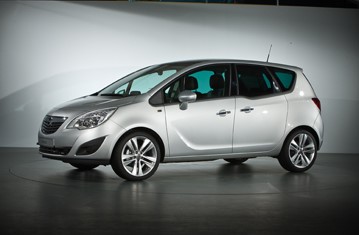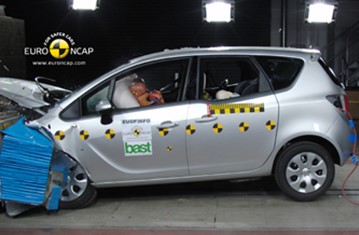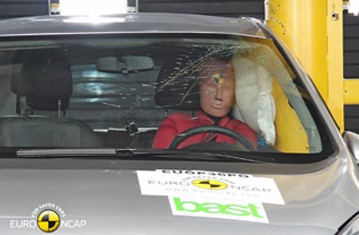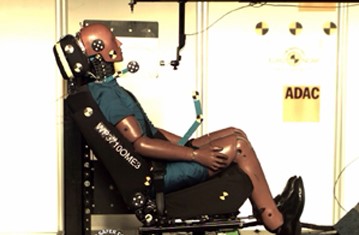Find more information in the General Comments section of the assessment
Find more information in the Rating Validity tab of the assessment
- See More
- See More
- See More
- See More
- Good
- Adequate
- Marginal
- Weak
- Poor
 Passenger
Passenger
 Driver
Driver
 Front Seat
Front Seat
 Car
Car
 Pole
Pole
- Good
- Adequate
- Marginal
- Weak
- Poor


Passenger
outboard
center
Fitted to the vehicle as standard
Not fitted to the test vehicle but available as option
Not Available
Opel recommend an unusual method of installation for the restraint of the 3 year infant: as well as being fitted using the ISOFIX and top tether anchorages, the adult seatbelt is also used to secure the restraint. Meriva owners should be aware that this is the method of installation used by Euro NCAP in its tests and that the scores and ratings given to the car reflect the performance of the restraint when used in this way. Forward movement of the 3 year dummy in the frontal impact was not excessive. In the side impact, both the 18 month and 3 year dummies were properly contained by the protective shells of their restraints. The passenger airbag can be disabled to allow a rearward facing child restraint to be used in that seating position. However, information provided to the driver about the status of the airbag is not sufficiently clear. A permanently attached label warns clearly of the dangers of using a restraint in that position without first disabling the airbag.
- Good
- Adequate
- Marginal
- Weak
- Poor

Head Impact 15.0 Pts
Pelvis Impact 0.9 Pts
Leg Impact 4.0 Pts
The bumper provided good protection to pedestrians' legs in most areas, but was poor in places. The front edge of the bonnet provided poor or marginal levels protection. In most areas where the head of child might strike, the bonnet provided good protection. However, for an adult, the windscreen base and the A-Pillars offered predominantly poor levels of protection.
- Good
- Adequate
- Marginal
- Weak
- Poor
| System Name | ESP | |
| Performance | ||
| Applies To | All seats | ||
| Warning | Driver Seat | Front Passenger(s) | Rear Passenger(s) |
| Visual | |||
| Audible | |||
|
|||
Electronic stability control is fitted as standard equipment. The front seating positions have a seatbeltt reminder as standard. A reminder system is also available as an option for the rear seats; as it is expected to be fitted as standard equipment in the great majority of sales, the system qualified for assessment by Euro NCAP.
- Specifications
- Safety Equipment
- Videos
- Advanced Rewards
- Rating Validity
Specifications
Tested Model Opel Meriva 1.4 'Enjoy', LHD
Body Type - 5 door MPV
Year Of Publication 2010
Kerb Weight 1359kg
VIN From Which Rating Applies - applies to all Merivas of the specification tested
Class Small Mpv
Safety Equipment
Note: Other equipment may be available on the vehicle but was not considered in the test year.
Fitted to the vehicle as standard
Fitted to the vehicle as option
Not fitted to the test vehicle but available as option
Not Available
Not Applicable
Videos
Advanced Rewards
Rating Validity





Find more information in the General Comments section of the assessment
 Share
Share











The passenger compartment remained stable in the frontal impact, the windscreen pillar being deformed rearward only 3mm after the test. There was no excessive deformation of the driver's footwell or dangerous tearing of the metal. Dummy results indicated good protection of the knees and femurs for the front seat occupants. Additional tests showed that a similar level of protection would be offered to occupants of different sizes and to those sat in different positions. In the side impact barrier test, the car scored maximum points for the protection it offered the driver. However, in the more severe side pole impact, deformation of the dummy's ribs indicated weak protection of the chest area. The seat and head restraint provided good protection against whiplash injuries in a rear-end impact.